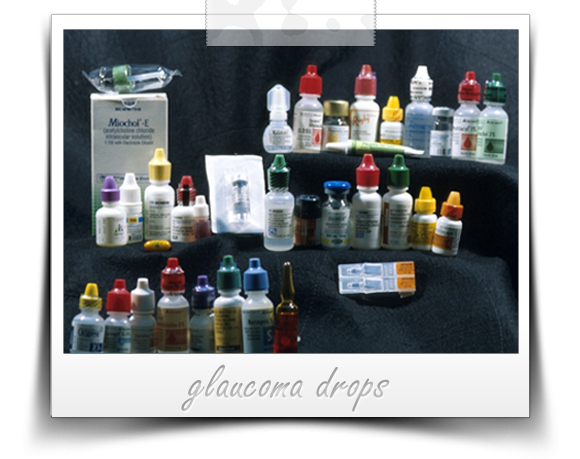With a patient’s sight on the line, glaucoma is a race against time. For every increase in intraocular pressure (IOP), a person with glaucoma slowly inches her way towards blindness. A glaucoma specialist therefore must address this process by keeping her patient’s eye pressure level at normal or low-normal levels. Fortunately, a wide range of glaucoma treatment options are available nowadays, from simple eye drops to procedures such as laser ablation, invasive surgeries such as trabeculectomy, to the more recent and less invasive ones like canaloplasty.
Glaucoma Treatment Options

Glaucoma Drops have evolved from miotics (pilocarpine), carbonic anhydrase (dorzolamide), beta blockers (timolol), alpha agonists (brimonidine), to prostaglandin analogs (latanoprost, travoprost) and various combinations of these. Although many of these drugs have been used as glaucoma treatments for decades, patients who are sick or elderly, who have existing systemic diseases like diabetes, asthma, heart blocks, may experience significant side effects with glaucoma drop treatment. Issues such as compliance can also be a challenge for doctors and their caregivers due to the inconvenience of applying the medication several times in a day. Moreover, because of the above mentioned issues with topical therapy, many glaucoma patients eventually resort to glaucoma surgery or other invasive procedures such as laser trabeculoplasty.
Laser One of the alternatives to using glaucoma eye drops is Laser Trabeculoplasty (LT). Unlike drugs, laser has no systemic side effects. This makes it well suited for high risk patients who are either too ill or too old to undergo surgery or tolerate medical treatment. Laser technology creates small burns in the anatomical part of the eye responsible for draining the aqueous fluid, thereby increasing outflow and decreasing intraocular pressure. It can be likened to clearing debris from the drain in order to relieve a clogged sink. Although studies have shown that LT is as effective than medication alone, it is known to lower IOP only temporarily and has a high failure rate. In one study, half of the patients who had previous LT eventually underwent the filtering surgery (trabeculectomy) after five years.
Glaucoma Surgery Trabeculectomy, the classic and oldest among filtering surgery is considered to be the “gold standard” with regard to maximally reducing IOP. It requires creation of a fistula to drain the excess aqueous fluid. Although there have been various permutations of the procedure over the years, ranging from implantation of artificial drainage devices to the addition of drugs like (5-FU) and mitomcycin, the danger of surgical failure as well as sight-threatening eye infection always looms.
Minimally-Invasive Surgery With the advent of non-penetrating surgeries such as viscocanalostomy and canaloplasty, the Holy Grail of safer, effective glaucoma surgery may now be possible. Considered by many eye surgeons as the next frontier of glaucoma treatment, canaloplasty possesses the efficacy of filtering surgery without its attendant risks. Promising though non-penetrating techniques like canaloplasty may be, they are still relatively underutilized due to the lack of qualified surgeons who can perform them. Only a few glaucoma surgeons have completed the training necessary to offer this procedure to their patients with glaucoma. Dr David Richardson is working to change this as he has devoted many hours to training other glaucoma surgeons in the technique of non-penetrating surgery.
With many breakthroughs in medicine over the past few decades, there is a wide range of effective glaucoma treatment options available . If you or someone you love has glaucoma, we hope this article gave you an overview of the modern treatment options. Ultimately, however, only your eye doctor or a glaucoma specialist can provide the proper evaluation required to initiate a treatment plan tailored to your needs, glaucoma severity, and preference.
References
- Marcocci L, Packer L, Droy-Lefaix MT, et al: Antioxidant action of Ginkgo biloba extract EGb 761. Methods Enzymol 234:462–75, 1994an P: Lipoperoxidation induced by hydrogen peroxide in human erythrocyte membranes. 1. Protective effect of Ginkgo biloba extract (EGb 761). J Int Med Res 23:1–8, 1995.
- Braquet P: Proofs of involvement of PAF-acether in various immune disorders using BN 52021 (ginkgolide B): a powerful PAF-acether antagonist isolated from Ginkgo biloba L. Adv Prostaglandin Thromboxane Leukot Res 16:179–98, 1986.
- Kleijnen J, Knipschild P. Ginkgo biloba for cerebral insuf?-ciency. Br J Clin Pharmacol 1992;34:352–8. Ritch R. A potential role for Ginkgo biloba extract in the treatment of glaucoma. Med Hypotheses 2000;54:221–35.
- Quaranta L, Bettelli S, Uva MG, Semeraro F, Turano R, Gandolfo E. Effect of Ginkgo biloba extract on preexisting visual field damage in normal tension glaucoma. Ophthalmology 2003;110:359-62.
- Le Bars PL, Katz MM, Berman N, et al. A placebo-controlled, double-blind, randomized trial of an extract of Ginkgo biloba for dementia. North American Study EGb Group. JAMA 1997;278:1327–32.
Don’t delay getting checked for glaucoma.
Make an appointment with an eye doctor in your area now. If you live in the greater Los Angeles area and would like Dr. Richardson to evaluate your eyes for glaucoma call 626-289-7856 now. No referral required. Appointments are available, Tuesday through Saturday.


